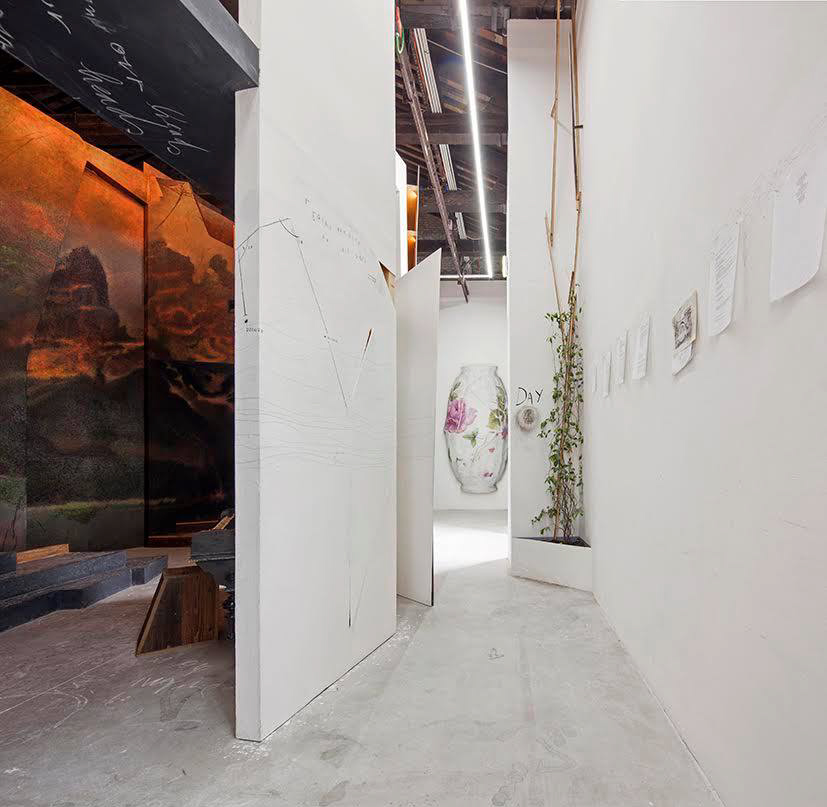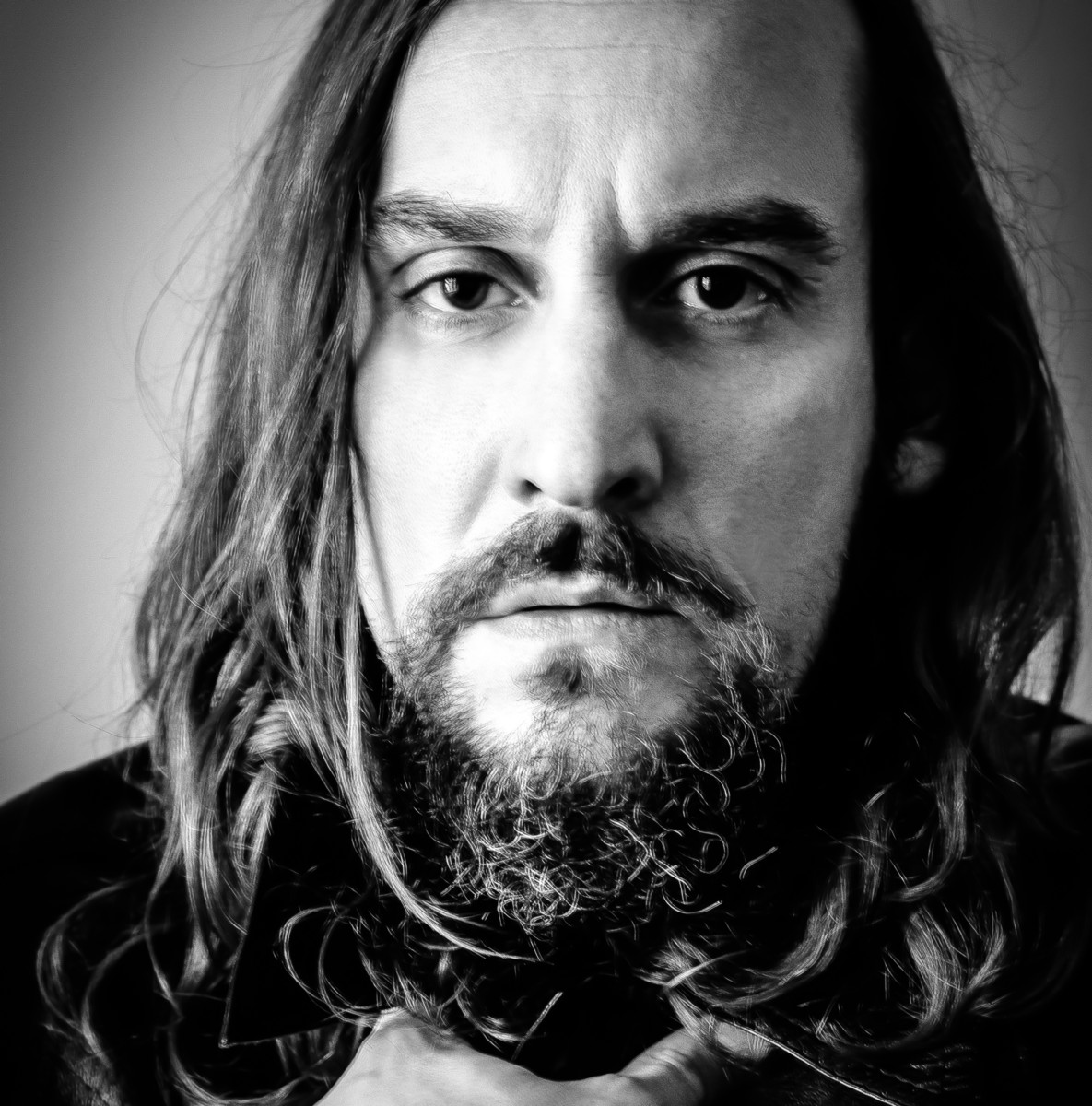
Last year, in mid-August, I stood inside a house that stood inside another structure—that external structure the long-retired arsenal for the Serenissima military, and now, centuries later, home to the Venice Biennale. The arsenal once housed arms; today it houses art. In this structure, warships were once built. Although the building has been strikingly repurposed, it belongs today, just as it once did, to making—to creative violence and dedication.
From May 9 to November 22, 2015, the arsenal became a temporary home to UTTER/the violent necessity for the embodied presence of hope, a work created by JAŠA for the Pavilion of Slovenia as part of the 56th Venice Biennale. UTTER was defined by its walls—as walls anywhere separate what is in from what is out. But UTTER’s walls were made of sound, paint, script, and by the presence of its performers, as equally as they were built from wood. Under the influence of these mediums, UTTER’s walls were mutable, unfixed.
UTTER’s walls stood at approximately nineteen feet, with varying ups and downs. Each week of the Biennale, for seven months, JAŠA and his collaborators performed a series of actions; layered with their movements, they performed a script (written by JAŠA and the writer, Etan Nechin). The collaborators marked the walls with floating angles, circles, words, fragments of meaning—and all of these existed in dialogue with one another, and with sculptural elements. On one wall, clock hands were fixed around embedded circles (drawn in pencil or charcoal), much like the rings of a tree. On Mondays, when the Biennale was closed to the public, the collaborators painted the walls of the house white, covering all evidence of their work. On Tuesday (Day 1 of the script), they started again.
I circled the exterior, in the boundary between UTTER and the Biennale. I orbited until I entered, carried through a doorway by music, at once ominous and uplifting. Once inside, I walked on words. Someone had written an essay in chalk—words covered the floor, and however I moved forward, I was rubbing them out. I tried not to, I wanted to read, but it was impossible. I had only just arrived, and already I was doing this violence, enacting an erasure. And, as I understand it, this inevitable action was also part of the performance, calling out to me—to bring me out of the role I had been playing all day, just as a person walking in the world—to bring me out of this role and into it. As open as the exterior of the house felt (full of time and memory and light), so the inside was darkened by closed walls, and by the pointillist landscape that was in the process of being made—artists stood on ladders, painting with dots. Other collaborators moved through this landscape—writing, making music, singing, speaking, gesturing, and standing still. To utter is not merely to speak, but to call forth, to bring into being. At times, there was a specific tenseness in the house that seemed traceable to audience discomfort. It was the discomfort of being called to action in the absence of any knowable action, any knowable way of proceeding.
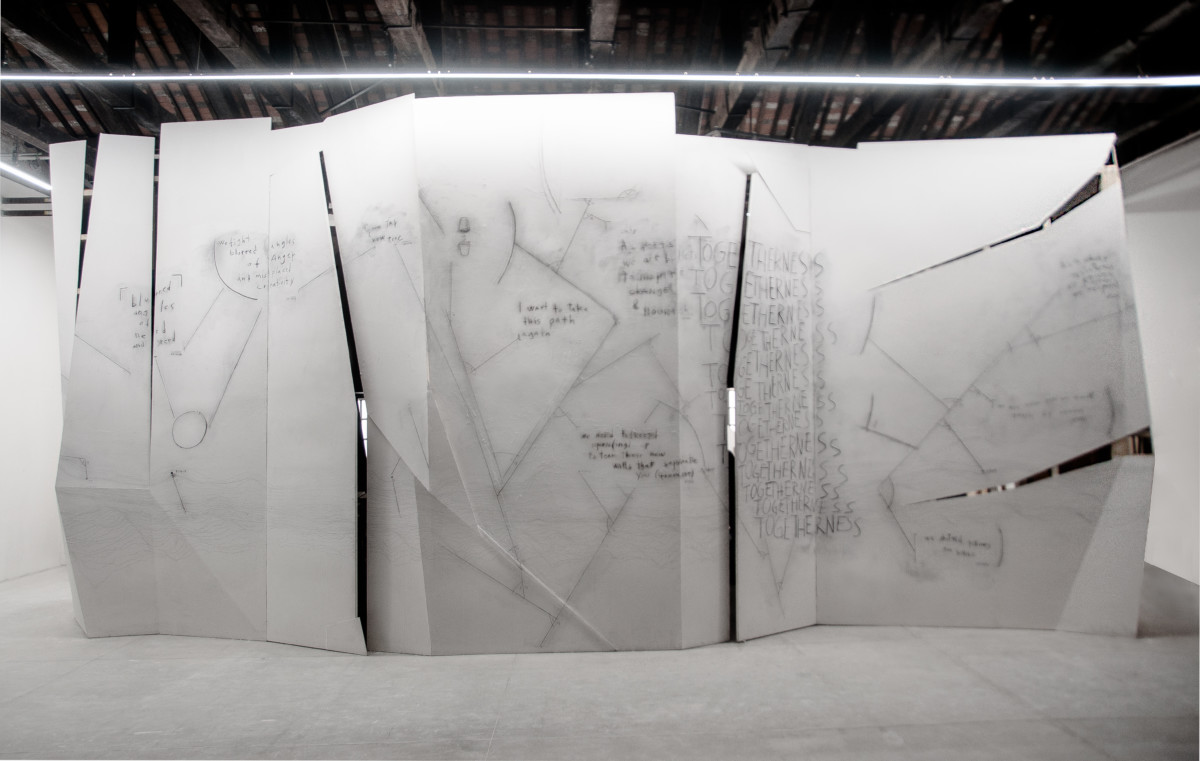
As UTTER slipped between its mediums, it shuttled its viewers to new emotional locales. If any house contains what (and who) it holds inside, then this house (and those in it), pushes its contents outward, into the very spaces and the bodies it encloses—into the bodies of the viewers—just as if the walls themselves were ideas, thoughts that could whisper themselves straight into ears. The piece was startling, as it offered this realization—though not all of us are poets, we might all behave poetically. The walls of UTTER spoke: “As poets/ we are bullets/ to inspire/ change/ and nourish.”
JAŠA’s voice bears a resoluteness that reminds me of the house itself—at once unwavering and fluid, and full of unexpected phrasings. And though there is nothing in his speech that resembles force, there is a kind of force field in his intonation, which seems to come from the consistency of his dedication to his work—it is the force field created by many years of artistic discipline—or so I imagine. In his statement about UTTER, JAŠA writes: “an artwork can become political, if the ideology is inspiring not dictating”—and yet, it is precisely the roominess this dictum creates, the openness of his philosophy paired with his creative authority that implicates the audience so totally, and makes the trifecta of requirements that JAŠA presents—of hope, collaboration, and resistance—so demanding and compelling. JAŠA does not speak of openness gratuitously; it is felt, not only in his work, but in his manner of communication. He has an ease with metaphor and a relationship to language that is uniquely untethered to the confines of conventional speech—indeed, he speaks as though he is translating, not necessarily from one language to another (though this is possible), but from the strictness of a governed syntax to a lingual macrocosm of his own making. JAŠA’s body of work has grown in the context of several countries and languages.
JAŠA was born in Ljubljana, Slovenia in 1978. He studied painting at the Accademia di Belle Arti in Venice, and has gone on to show his work to critical acclaim both in and outside of Europe, among these works, Untitled, 2015 (Istanbul, 2015), Crystal C (New York, 2104), and Gods Came for Dinner Last Night (Ljubljana, 2013, with Mark Požlep). JAŠA’s artistic practice is based out of two active studios—one in Ljubljana and one in New York. The work he cultivates in both studios is marked by a kind of integrative principle, which shows up in his continued commitment to collaboration, as well as in his multi-media approach. Most recently, JAŠA collaborated with ULAY on a site-specific installation and performance series, Water Mark / Cutting Through the Clouds of Myth (Kustera Projects, Brooklyn, 2016).
I spoke with JAŠA last year, just before the closing of the Biennale, and the disbanding of the house’s collaborators. We discussed, among other things, the freedom that exists within the limits of a doorframe, and the artist’s responsibility to hope.
Maura Pellettieri for Guernica
Guernica: UTTER is a creation of what you call embodied hope, which is a violent and political hope that requires collaborative parts in order to exist. The hope is violent but the action is collaborative, and so, nonviolent. Can you talk a little about what this means, and what the source of this work is in you? I am curious about your external influences but also the ways you have come to influence yourself, or were led to this work by previous works.
JAŠA: Let’s start with the aggression. All of it is absolutely a response to what I see happening around us at this very moment. When I was writing UTTER, I felt the urgency to respond. In my work I always start from some sort of personal boiling point, which then escalates and I try to give it a shape that is not about the personal story, but is instead addressing a more universal emotion. If UTTER started a year ago, the whole situation it came out of has escalated. Right now, both in and out of Europe, it feels like really illogical and hard-to-understand things are happening and everything is just escalating, is off track completely. Or at least so it feels.
To quote one of the texts that’s used in UTTER, “We fight and then it goes into blurred angles. We fight blurred angles of anger and misplaced creativity.” This is from one of the first sources for the project, which was a text I read that was about [Guillaume] Apollinaire’s violent hope. In the poem, Apollinaire is talking about a poet who wants to throw himself off of a bridge because his despair is so violent that he needs to act somehow, and so he goes into this final abyss.
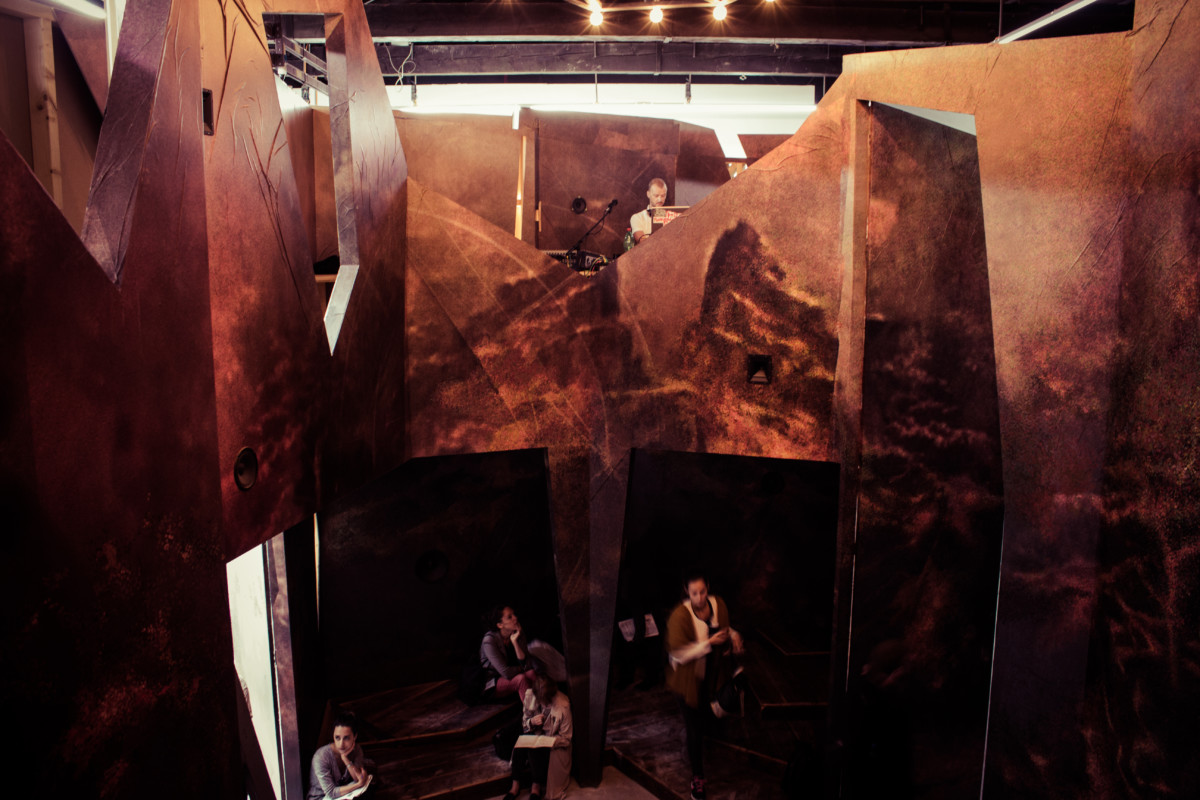
Guernica: You’re talking about the poem, ‘Le Pont Mirabeau’?
JAŠA: Yes. But I was also referring to a book by Stéphane Hessel, Time for Outrage! , which was one of the conceptual pillars of the project: “To create is to resist, to resist is to create.” This is one of the main messages of the book. Hessel was an extremely experienced politician who, at the end of his career and life, distillated what was for him the only alternative to the existing state of things. He wrote this book in reaction to his political experience, and it was taken up as a flag in all the outbursts in Europe two years ago.
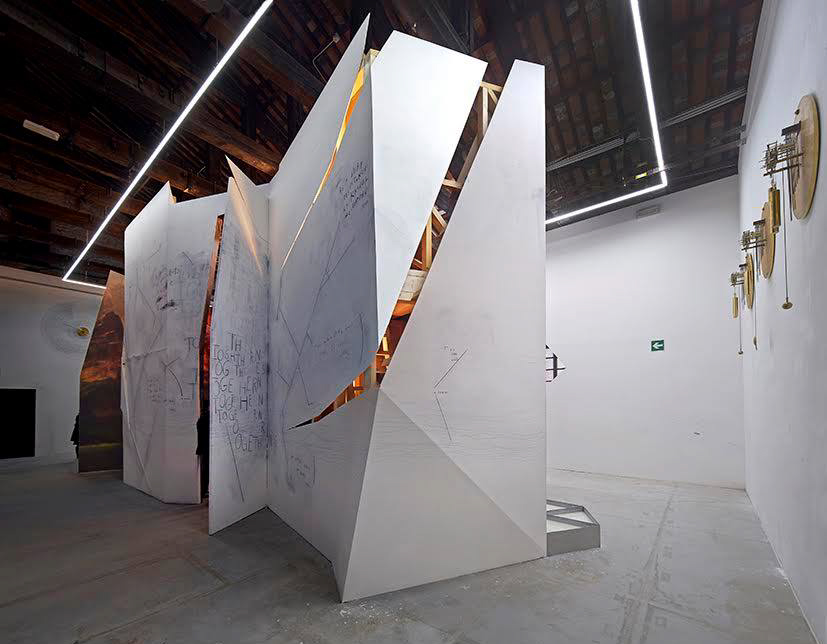
Guernica: Whose outbursts are you referring to, specifically?
JAŠA: Following the Arab Spring, protests started in parts of Europe and flooded into Slovenia as well. Many Left-oriented movements adopted the book as their flag. For me, this was a very constructive period—being in the midst of people in Ljubljana who found the courage to speak out, to express their malcontent in a very pacifistic and creative way. Somehow with time, it faded, even though in the next elections we saw the rise of a new Left party that had conceptual allies with other political parties in Europe, like Syriza in Greece. We were all following the Greek tragedy and many people saw this, and still see it, as the end of possible change in the politics of individual countries and in Europe’s idea of identity, generally.
With Hessel’s Time for Outrage! a generation was screaming for immediate change. Unfortunately, with what we are facing now, the response feels completely the opposite. Despair and aggression might seem like the most obvious or logical reactions, but I do believe that if we embrace these two emotions through a prism of hope—not only that we can do this, but that we have to, in order to resist effectively. My understanding is that as an artist, I cannot allow myself, now nor ever—or so I see my responsibility toward my vocation—to despair over my own personal situation. But through my work, I can channel how I feel about what is happening, and at the same time never taking the freedom to feel as if, with what I’m going to say, I’m going to resolve the big picture—but at the same time, to not despair within it.
So, not going through ways of cynicism or nihilism, and saying, “Oh, everything is fucked up, and it’s terrible.” I believe in art and through the power of art, I believe in humanity. Humanity can be constructive and positive, when the intelligence and creative force of it is channeled in the right direction. Going back to the subtitle of the piece, “the violent necessity”—that deals directly with the fact that aggressive impulses and destructive forces within the creative process can be, and are, very constructive. In my experience, these moments can be a birth for something very inspiring in the end, but I definitely don’t think it is constructive or positive in other fields, especially not in politics.
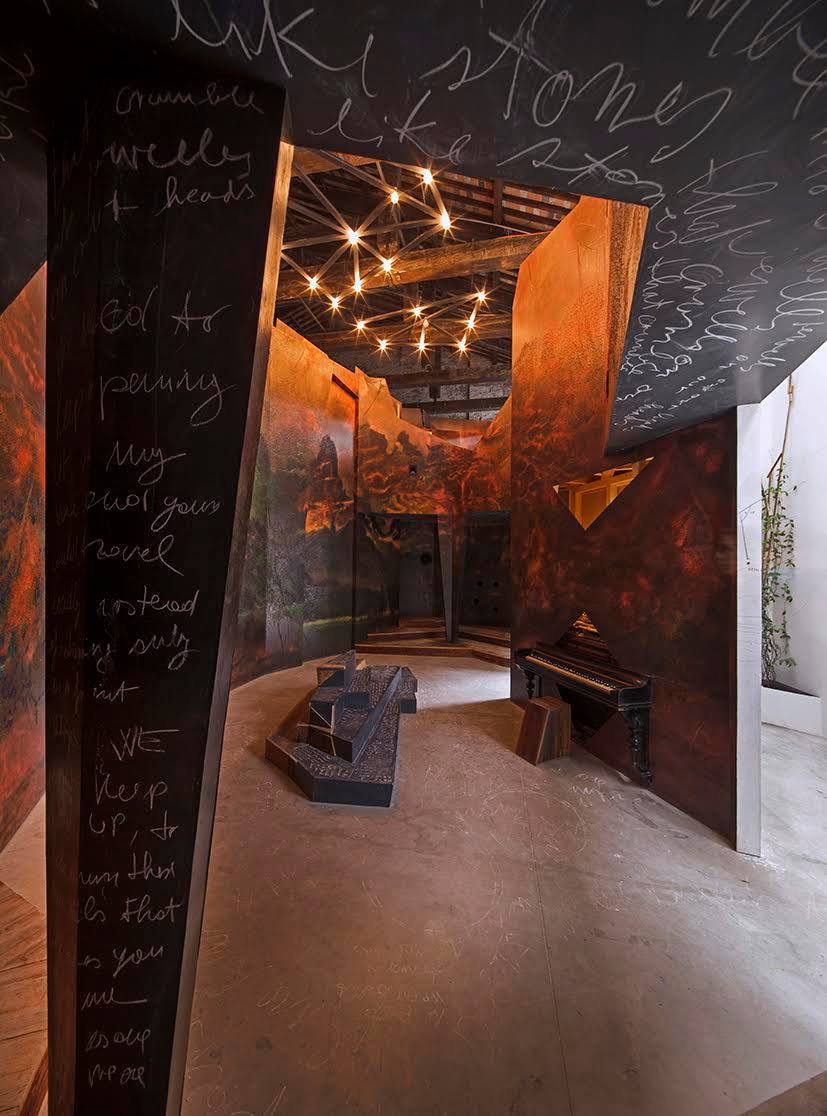
Guernica: After you conceptualized this project, how did it come together logistically, in terms of the construction of all the elements, but also as a collaboration that involved many minds?
JAŠA: UTTER is an instrument; with any instrument that you want to play well you need discipline. For me, this comes from painting. My main discipline is still painting. When I say discipline, I mean it in the sense of a disciplined act, going back daily, and in a way, as a routine, but of course when you embrace a creative process, it can never be routine—the routine is that you return to it daily. Here I can give the example of a very misinterpreted statement by [Joseph] Beuys: “Every man is an artist.” The way I understand it, and why I say it has been misinterpreted, is that it has been used too easily: “Everybody is an artist” is taken to mean, let’s celebrate the fact that everybody is special, because being an artist means, per se, that you are special. But it’s not true. The way I see it, “Everybody is an artist” means that whatever you’re doing, you do it creatively and responsibly. Beuys’ idea is this very pro-humanitarian, constructive, positive idea that everybody is an artist when doing his own job, his vocation, whatever it is, with passion and responsibility.
Going back to the collaboration, UTTER is such a complex instrument that I cannot play it on my own, and I would never like to play it on my own because the complexity that I wanted to channel can only be achieved when more minds play on it. At the same time, I know perfectly what it means to take on the responsibility of the captain of a ship, in the sense that everybody needs direction, they need to know where they’re going. Roles need to be decided and people need to know their roles—this is when they can best operate. I’ve been engaged in many collaborations where we just didn’t want to decide who’s who because we said, “It’s an open field, it’s democracy, everybody should have their own voice.” But it always ends up in fights, you know, who’s taking over, who’s not taking over. It is through the experiences of these open projects that I know you need a very disciplined and formal approach in organizing the collaborators. You need to let everybody know from the beginning, “this is your space, this is your role, and this is where we meet.” So then creatively, everyone can do his best, and for me, it can always remain a little open.
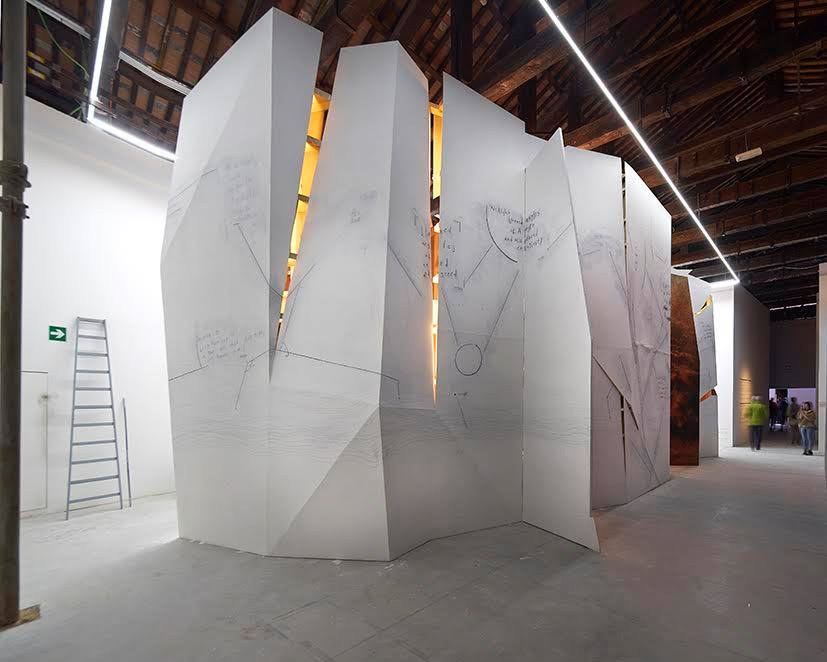
Guernica: You strike a very delicate, careful balance with your collaborators. It appears to be—both within the walls of UTTER, and outside of it—an ongoing part of your work?
JAŠA: Alchemy as an approach in my work is very important. Part of the text in UTTER even refers to it. There is this concept—when an idea is broken, (which means that you open up the idea), the idea comes out. It is like a medicine, you crack the little capsule, and then inside comes out.
Within all the structured thought of UTTER, the concept of it, there are always these deciding moments that you know will come, and when they do, they change everything. They come in drops, but in such distilled drops that they could change the color of the ocean. It’s exactly the same thing in collaboration. Trust and challenge are the two main drives. You need to challenge each other but you can only do it if you undoubtedly trust each other. Any idea is like a poison that is hidden in your blood, and when you spot it, that drop changes the color of your blood. It obsesses you. We all have this. Once you establish a relationship with this fact, the distillation grows stronger. And when you trust and challenge each other, it grows more. But when you distillate with others, it’s not only part of your blood anymore. If you decide to crack the idea open with others, you decide to risk it all. Because in cracking it open, in risking it all, it usually means that you will have to go very far and it’s very hard to predict what can happen. Fear, jealousy, and laziness can damage so many of these blooming moments. Doubt is always part of the process, but it is in trusting yourself and others, and at the same time, embracing failure and embracing that we are all in it together, that it is possible for something really great to happen.
Any idea is like a poison that is hidden in your blood, and when you spot it, that drop changes the color of your blood. It obsesses you. We all have this. Once you establish a relationship with this fact, the distillation grows stronger.
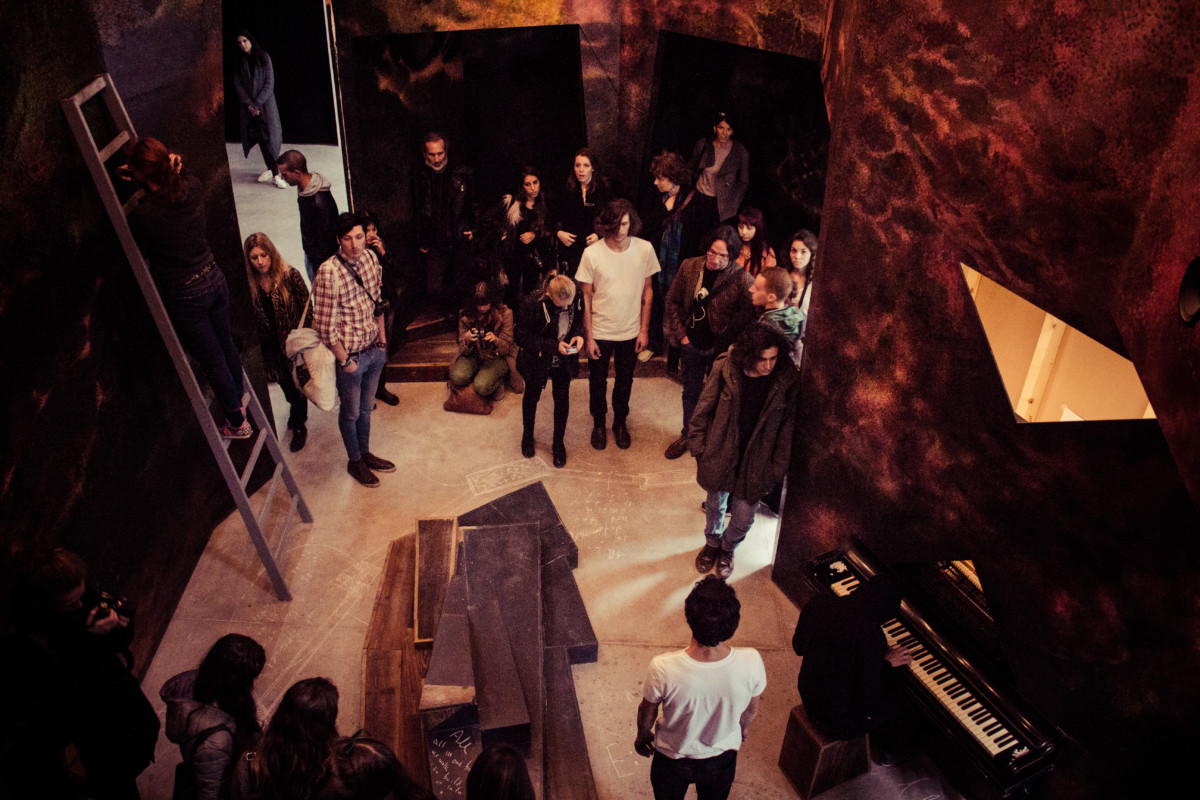
Guernica: This reminds me of the way that the walls create questions of ownership—who is inside, who is outside, who is we—and the question of whether the border is fluid or rigid. There is a distinct inside and outside in the structure, but there are also so many gaps in the walls—so that anyone can see a little bit beyond where they are. The house seems to always be breaking down or blurring boundaries even as it creates them.
JAŠA: For me, architecture always has been, in a way, a limitation to expression. My mother was an architect, so I was brought up as an architect. Whatever I did, every line that I drew as a kid and later on, it was always linked to that. I even started my studies as an architect, and then I fled from it.
Understanding architecture through an intimate relationship—my mother—I always understood the walls that could not be moved as limits to her own expression. Especially when, as a family, we were forced to live in an apartment that when she was out of a job became her practice, her studio, a continuous workplace, literally. There were constantly walls moving in our apartment. When she didn’t have work, my mother had to practice somewhere because she had so many ideas, and for me that always showed her state of mind, her emotional state. I could never look at the wall and simply say, “Yeah it’s nice there because it curves better, the living room, it plays better with the light.” I always saw it as an echo of a pain or of an unrealized vision that could have been someplace else. This is also an idea that comes through in the script—that architecture is always a materialization of somebody’s thought. For me it’s impossible to look at UTTER as just a piece of material. But at the same time, of course it is. So the walls reflect the limit and the possibility of expression. The way the form is made, how it’s shaped, comes from the conflict of these two extremes. In a way, every time I come into a space, and I try to work in a new form, I first see all the flaws and the difficulties and all the—well, let’s say, the screaming no’s in the space that will not allow me to say what I think has to be said.
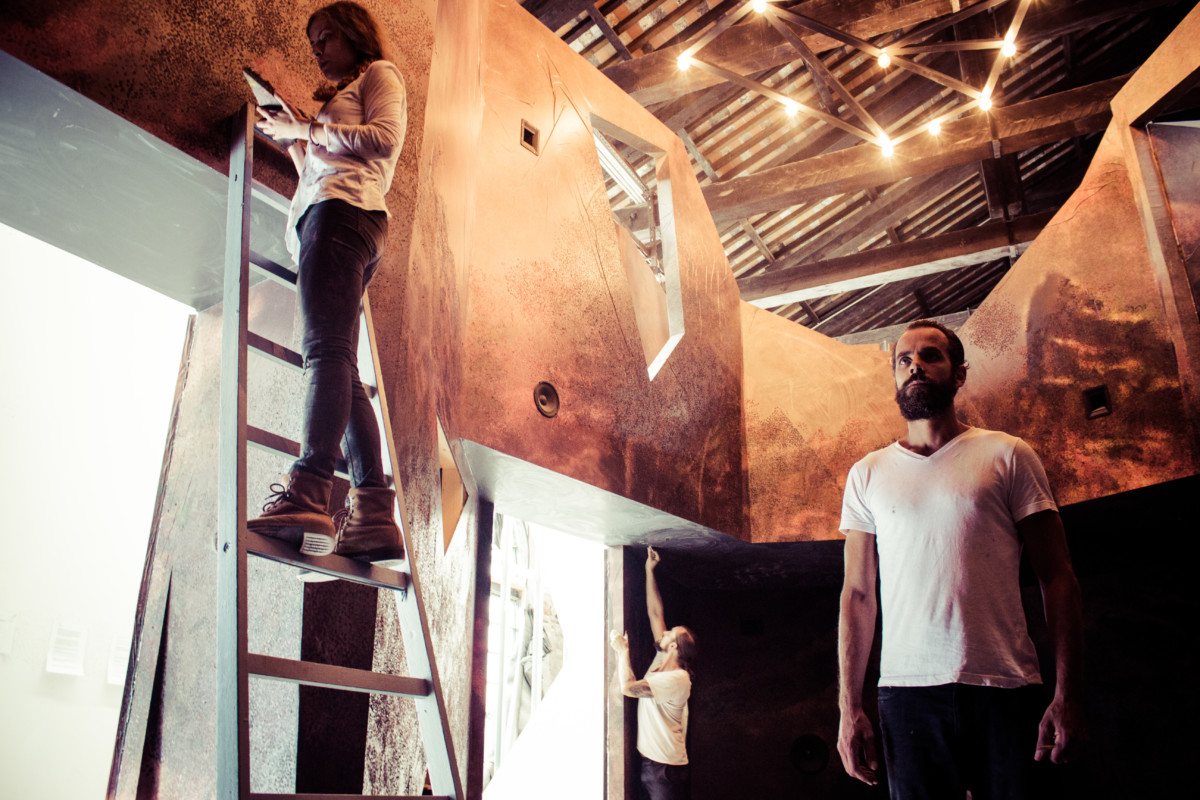
Guernica: This is a constant in UTTER—that through the fragments, gaps, and fractures, something is being called forth. Can you talk about the relationship of sound to the piece?
JAŠA: Music in relation to architecture is the shaping of time. Once I had shaped and molded the space, music helped me to shape the atmosphere, with the space and within the space. In the end, what I want to mold is the experience that the viewer feels. I like to see it as culture that I’m molding, that all of it is the experience. For me that’s the ultimate thing that you can do as an artist, to actually mold one’s experience. That moment then becomes like the slide—and the slide constructs the whole vacation, or the memory of the summer vacation. You can manage to mold one of these slides, a memory in someone’s experience. That’s the force of art.
Guernica: Memory and time both have strong physical presences in UTTER, through the figures on the outer walls—the pendulums, the clock-hands, and the reconstructed vase. Do you think of these figures as also shaping time?
JAŠA: For me, architectural form is never limited by time. It seems so because every construction stops in a precise moment, but through time the form leaves and marks our lives, and vice versa. When I create an architectural form as a visual artist, I have to work within and through an existing context of that form. It can be ignored, viewed as simply a given state of things, a material, but in reality, it embodies both the rational and emotional representation of people through time.
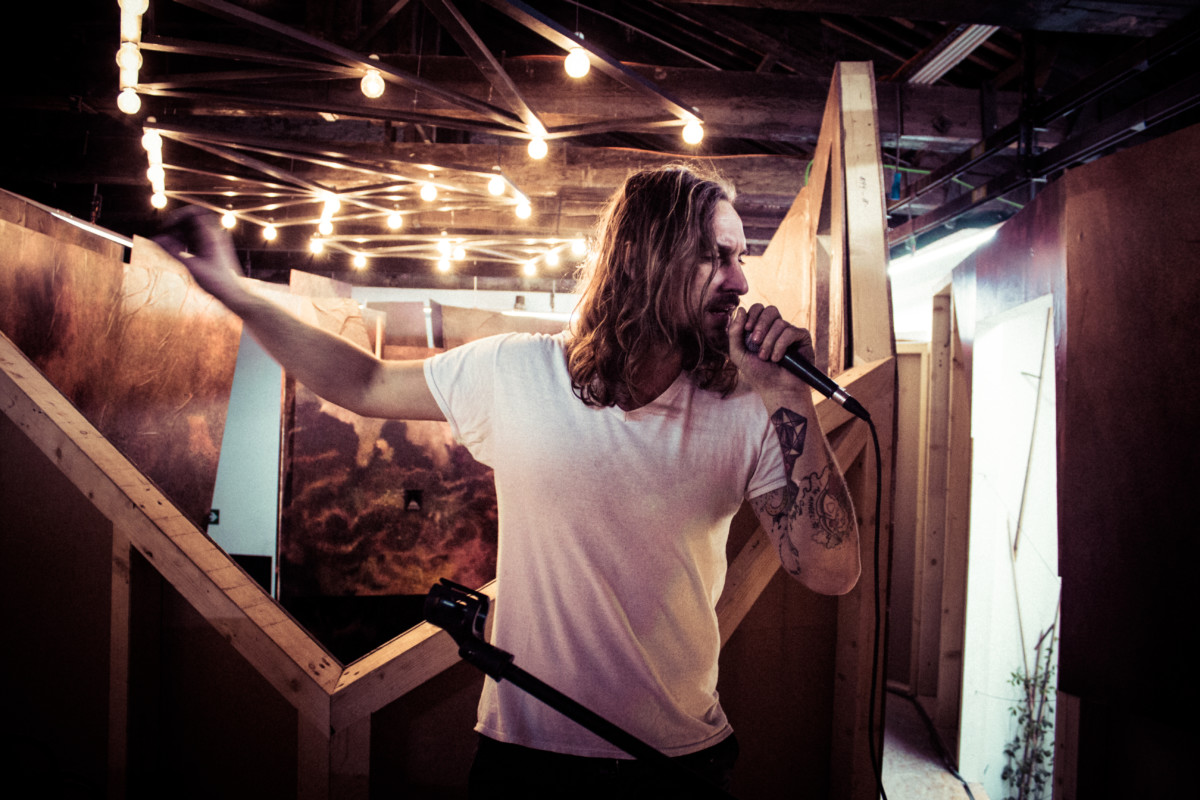
Guernica: So the architectural form itself embodies the codex of values?
JAŠA: Exactly. What is a precise codex of values? The text, the project—it is questioning this fundamental breaking point of our time and everyone as an individual. If we talk about us, the collaborators, we are all mainly children of the baby-boom generation, the hippie working class, those with intellectual atheist parents. We fairly understand the concept of freedom but at the same time, our generation is breaking all the records in what seems to be the epidemic of our time—depression. A character in the script, in one of his breaking moments, screams out to all present: “…give me a wall I can lean on.”
In UTTER, I constantly question what we should believe in so that the thought can become a grain. I never gave a direct answer, or a simple one-liner saying, “This is how it is,” because I simply don’t believe in the credibility or dictatorship of one thought. A grain inspires you. And as a consequence of that grain, you can comb through your existence differently. One of the main challenges for me, and the whole team, has been to go back to the beginning grain at the start of each new week. I have to question the very fundamentals, the essence of what I am communicating daily, with no gloves, no reservations whatsoever—especially in relation to myself.
In UTTER, I constantly question what we should believe in so that the thought can become a grain. I never gave a direct answer, or a simple one-liner saying, “This is how it is,” because I simply don’t believe in the credibility or dictatorship of one thought. A grain inspires you. And as a consequence of that grain, you can comb through your existence differently.
Guernica: One of the things that is so gripping about UTTER is the very particular way it makes the viewer a participant. There is no escaping involvement. The intimacy arrives from all of the components—the sound, the script, the closeness of the walls, but also the energy between performers, which then gets directed outward to the witnesses (the viewers). And sharing this can create intimacy between strangers. As if, against all odds, we’re connecting. But I am wondering how the relationship to the audience feels from your perspective?
JAŠA: When you get somebody, and you can feel that they are feeling it, that of course uplifts the whole performance. Then the channeling becomes so much easier because you can feel that it’s going somewhere and things just click. Going back to the feeling of intimacy, it’s the space itself, the way it was conceived, how one should feel inside it, how one can walk around. Of course all of it was very thought of, and this is where I always go back to the structure, and the text. It’s all about the precise codex of values that defines everything. In this kind of project that stretches out to all the elements, from the very structure to each tone or word that comes out.
An example of things not working is when someone from the public comes in, and out of pure anxiousness has to put his or her hands on the piano. When wrong tunes come into the space, it just doesn’t feel right. It’s such a thin line between getting it right and getting it completely wrong. Being there, working on the piece with the public, it’s far from being an interactive piece. It’s not. It’s not about—you come in, press the button, and things start flying around the room, and you feel that everything is there just for you. Everything is there for you—that’s the aim of an art piece, be it a painting or an instrument like UTTER that combines many mediums into one—but a word, a tune, the wall, if they don’t work together, it just doesn’t work. All of the careful tuning of the work, in the preparations, and then in the realization itself, the aim was always to make them fit together. That is always the challenge, and it has been the challenge for the past seven months. Because even though we had the script and we knew what we were doing, we always had to click, we always had to find the right feeling so the movement of Michele downstairs, the music that Bowrain is playing, everything we are doing, it matters that we are synced, that we know where we are getting.
One of the things that makes all of it easier is that I am directing as we go. We sit down in the morning, we make a plan in advance, but I direct the rhythm from day to day. Because this applies to how the day goes—the light, the humidity, honestly, all these elements change the atmosphere so much, and of course, the public—who is there, what I feel from their presence—so I’m constantly tuning the elements in and with the space. It’s about presence, but also about knowing what is happening with what we are doing and how is it being taken. A lot of times I’ll just shift the situation completely if I feel it’s not going the right way.
It has never been about the performance per se. I have used many different live moments and elements, from the group of students painting the inner landscape to Junzi and Bowrain playing live music, literally having a concert within the space, every day for seven months, all day long. Michele and myself are the main performers, shifting roles between gestural performance and dialogue. My role, as a director and performer is to tune the elements and foresee the needed changes in order to keep the durational performance dynamic alive for seven months. The public grasped the fact that they missed the beginning and they would probably never see the end. Already, that is a very strong emotion I wanted to channel. But I never leaned on it as the only one. For the viewer, what he or she experienced was always a carefully molded moment in time. Sometimes it hits you and sometimes it caresses you, as the subtitle suggests.
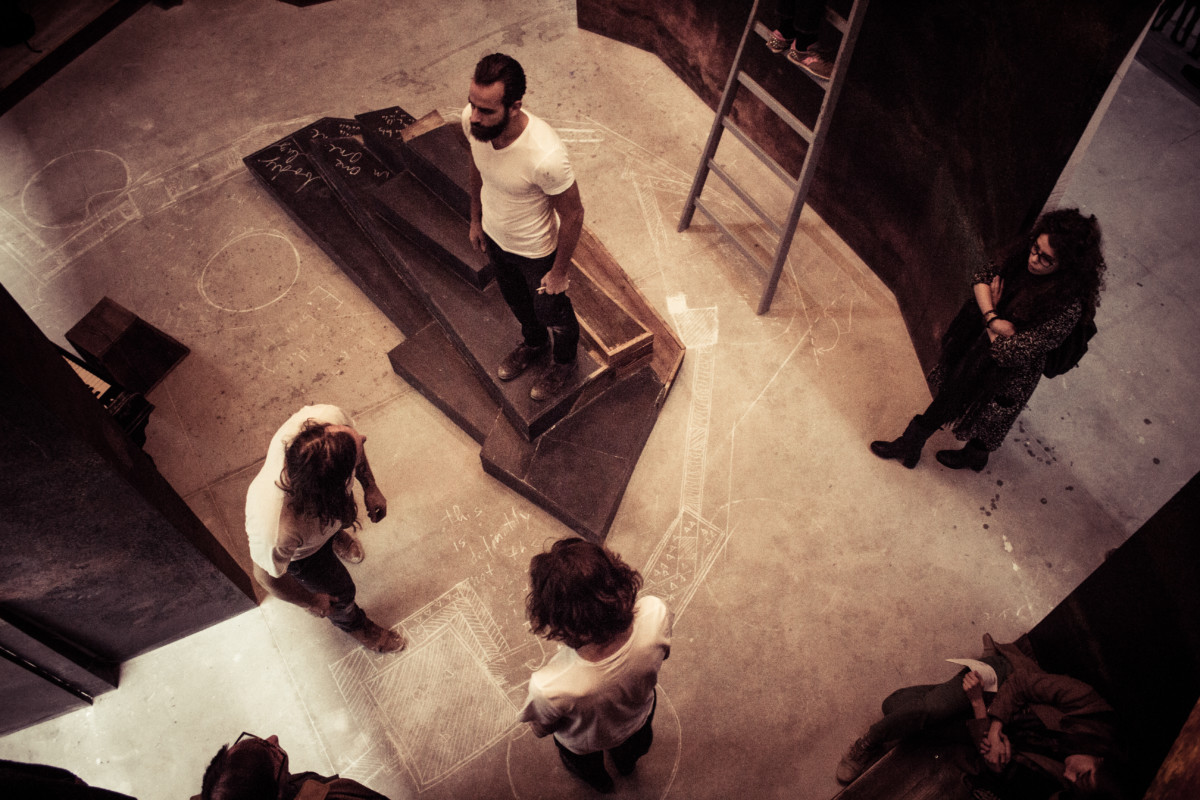
Guernica: As the weeks and months passed, did you find yourself incorporating more improvisation or did the plan stay fairly strict each day?
JAŠA: I changed things, but the bones were always there. The script proved itself, as did the architecture, as did the whole technical setup and of course, all the experiences between all the main characters: Michele, Bowrain, Rosa, Meta. All the artists I’ve been working with for a while—we know each other’s sensibilities and talents, so within this, you know what can happen. There were things I added, or better, I discovered on the way, but somehow they were within the work, within the parameter, the field that we decided to work within in this space. It reminds me of what one of my first professors, Tone Rački said, when we were drawing. It was in the beginning weeks and he was all about discipline: “Draw this again and again. Draw this again and again.” He would say, “Look, if I give you a blank piece of paper, and say, just draw whatever you want, you’re going to get lost. If I send you out on an open field, you won’t know which direction to go in. But if I tell you to stay within the frame of the door, this is where you’re going to find freedom.” In advance, we had a clear frame within which we would work, and within this frame we found other things, but they were already within the same frame. It wasn’t as if, out of anxiety and paranoia, things were not working, and we started pulling in elements from god knows where just to make it work. I think the best thing all the way was that there was no anxiety.
At the end of the day, the project was about an emotional experience, or better—through a precise penetrating and sublime emotion, the message of the project came through. Toward the end, I was adding more and more elements, but at the same time, each day and week had its own unique and powerful feeling. There was one thing about UTTER’s structure that was maybe not put in words, but was so present: if you didn’t give it all in every moment, it just didn’t resonate. Now it’s amazing because we are so into it, we are so oiled, and the same time we are human beings, so we cannot just spritzen all the time. We have moments that I say, “Let’s go for two hours into complete abstraction and then we are going to start going up, with the rhythm.” When we go up in the rhythm for two or three hours, we do everything one by one in an extremely dynamic way with a lot of pauses, peaks that go left to right, and that’s all within the day’s script.
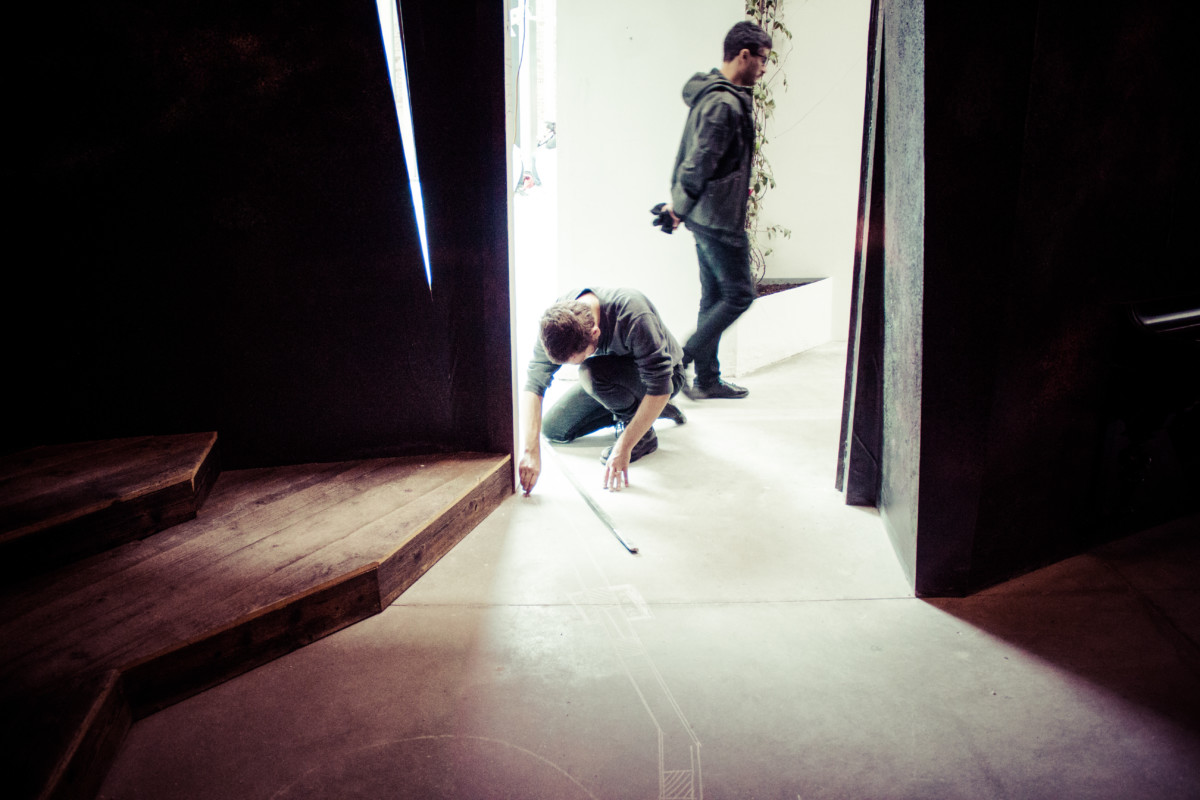
Guernica: On Day 102 of the project’s online diary, you make a statement that coincided with the opening up of the UTTER’s walls:
. . . the Pavilion of Slovenia has concentrated on the fact that the project is in the duty of representing a country as a part of the European Union in this adverse time; due to this reason, week 20 has been solely dedicated to a clear and loud statement: ‘We need to (keep) open(ing) up!!!’ In days like this the stance, or better yet – no stance – of Slovenian and European questionable politics is shameful. So many unclear passages of colors and positions, when in front of our eyes we have a crisp, clear picture of human to human responsibility, where there should be no doubts.
Was it always in the plan of the performance to open the walls in this way, or did you alter what you were doing in reaction to the information that was coming out about what was going on in Syria, and then what was following in Europe?
JAŠA: In the post it’s stated that Slovenia is now a country, and I’m the artist of the Slovenian Pavilion. Right now, Slovenia is not closing up the borders, but they are building up the fences, and the whole situation is extremely critical. I honestly had a very difficult moment of understanding my position within the whole discourse and what was happening. On the same day that Slovenia says, “We’re going to close the borders,” my script says that on this same day the structure is closed, so we were not doing anything different from Slovenia.
We can still say, it’s simply a metaphor. But the walls within the structure itself are never only walls because they’re also part of a sculpture. These specific walls are used as surfaces of expression, and within that expression, there is a continuous return to actions that don’t make sense. It’s not that they don’t make sense—it’s a sort of a Sisyphean action. For example, the painting with dots that is going on the whole time, and us, writing, then canceling, and also painting over the wall every week. And us doing all of that is shaping the air. Art is always shaping the air, that’s the force of it. By shaping the air, you can always curve the lines of how you express yourself and the language you use, and this is when it came to me—that instead of writing on our walls while being closed, we need to keep opening up. And this was also meant to be understood—that people knowing that we were there for six months probably meant that we would like to get out.
So it’s playing on the situation of the performance, but at the same time, it was directly addressing the state of mind—to open up means to accept the fear of the new, the whole process. I always go back to the creative process, in which you meet fear in so many stages of creating something, and you learn so much about it. As an artist, I can talk, and I can take the freedom—no, not the freedom but the responsibility to talk about that—that yes, it is very hard to open up, but it’s needed. It’s an absolute. And in the situation that Europe is facing, what we are seeing now is that we are going in two completely opposite extremes: a closing off, not fences necessarily, but through outbursts of complete angst, and also a lot of amazingly beautiful actions. So being within the context of countries, or of artists representing countries, I absolutely felt the need to directly comment on that while always staying within the frame of the art piece, which UTTER is and was from the beginning.
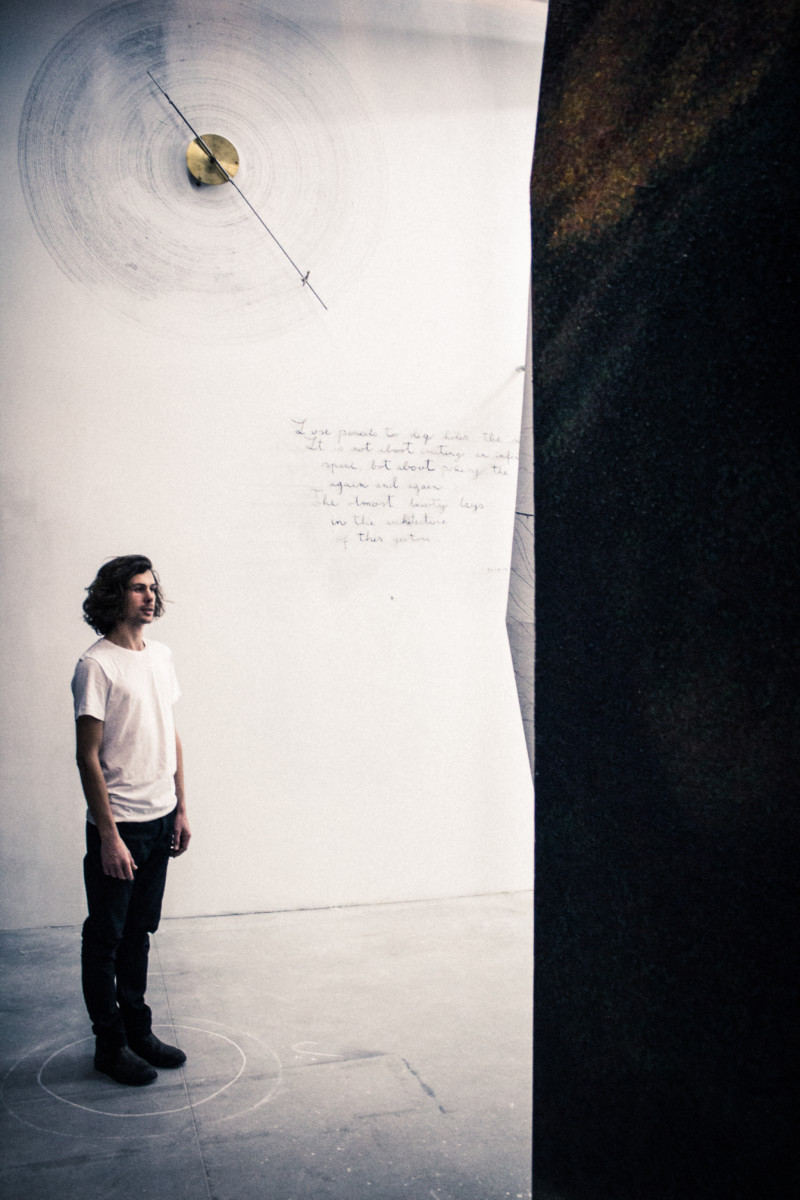
Guernica: There is this moment in the performance when one of your collaborators, Michele Drascek, is carrying a block on his shoulder up and down steps. There is the Sisyphean invocation here, the act at once meditative and labored, yet at the same time, Michele’s performance is aligning with two concepts that come up repetitively in the piece: precision and discipline. Do you think precision and discipline have a relationship to resistance?
JAŠA: In this context, the only legitimate way to see resistance is to resist within the conviction that a different language not only can exist but does exist. I think that that’s not only a must, but this is really my and our responsibility. As an artist or a group of artists. It doesn’t mean we are all screaming into the same horn, and that I have molded this horn, but that there are different organisms rotating in different directions, and where we meet, we might create cracks, but this is what it’s all about.
The figure, the man deciding over and over again to take the burden upon his shoulders can be seen as completely heroic as can be seen as completely Sisyphean, and it’s meant to be seen as such. That’s the core of the whole project. It’s intentionally and consciously tip-toeing on the edge of these two extremes, where you don’t know where it’s going. Am I faced with a hero, or am I faced with a lonely romantic human being? But this is who we are, and the force of art is to present complex beings, not one-dimensional, commercial-like people—like someone saying, “Take this perfume, and then you’re going to be like that”—not to go in the banal. We are precise beings because we have the intelligence to be so, but we have hearts, so we are romantic beings. When these two poles fight, they create a lot of beautiful and a lot of ugly things. There can only be an attempt at continuous balancing of the two. I thought for a while you can either find the one or the other, but somewhere along the way, I realized that it’s not about that, but it’s actually about continuous tip-toeing, and that’s it, and you can master that, and probably you won’t, but that’s the whole thing, it’s resisting within it. And that is why it’s “violent necessity,” but it’s also “presence of hope.” And the whole atmosphere is constantly shifting from one to the other—intentionally creating anxiety, and then a completely melodic landscape that embraces you and gives you comfort, but as soon as it gives you comfort it’s going to slap you out of it. The point is in the in-between, which is not a limbo, it’s not a space that’s not defined, it’s far from it, no?
The figure, the man deciding over and over again to take the burden upon his shoulders can be seen as completely heroic as can be seen as completely Sisyphean, and it’s meant to be seen as such. That’s the core of the whole project. It’s intentionally and consciously tip-toeing on the edge of these two extremes, where you don’t know where it’s going.
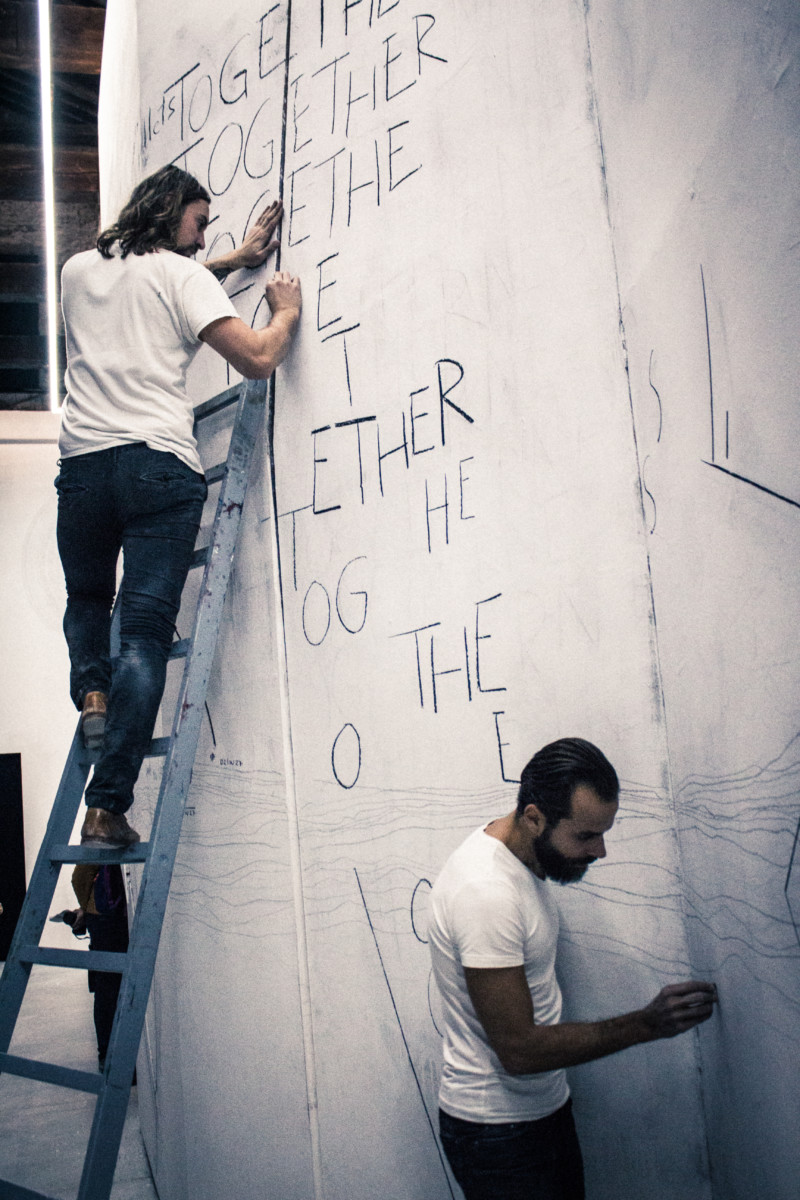
Guernica: UTTER gives this sense—a permission to feel or enact something that often escapes us—the feeling that there’s another way to be in a space, to exist with or within this tension we feel.
JAŠA: There’s a line in the text: “We decided to see the sky instead of these walls.” I’m talking about Gordon Matta-Clark and his relationship to architecture and expression. I’m in a small room, but I want to see the sky—he literally did that. If we go back to the experience of architecture, again, it’s a manifestation of somebody’s thought. In any kind of space, you leave a thought of somebody else. Yes, they are just lines, but somebody decided to put these lines there. And there’s nothing wrong with that, but there’s also nothing wrong with applying your own romantic view on top of it, on top of the precision of somebody else. There’s nothing wrong with going through it in a direct, punkish, anarchic way, because in art you can destroy, and in art you should destroy, and then rebuild or build again. But it’s terrible to see all of this happening as misplaced creativity in all the other fields.
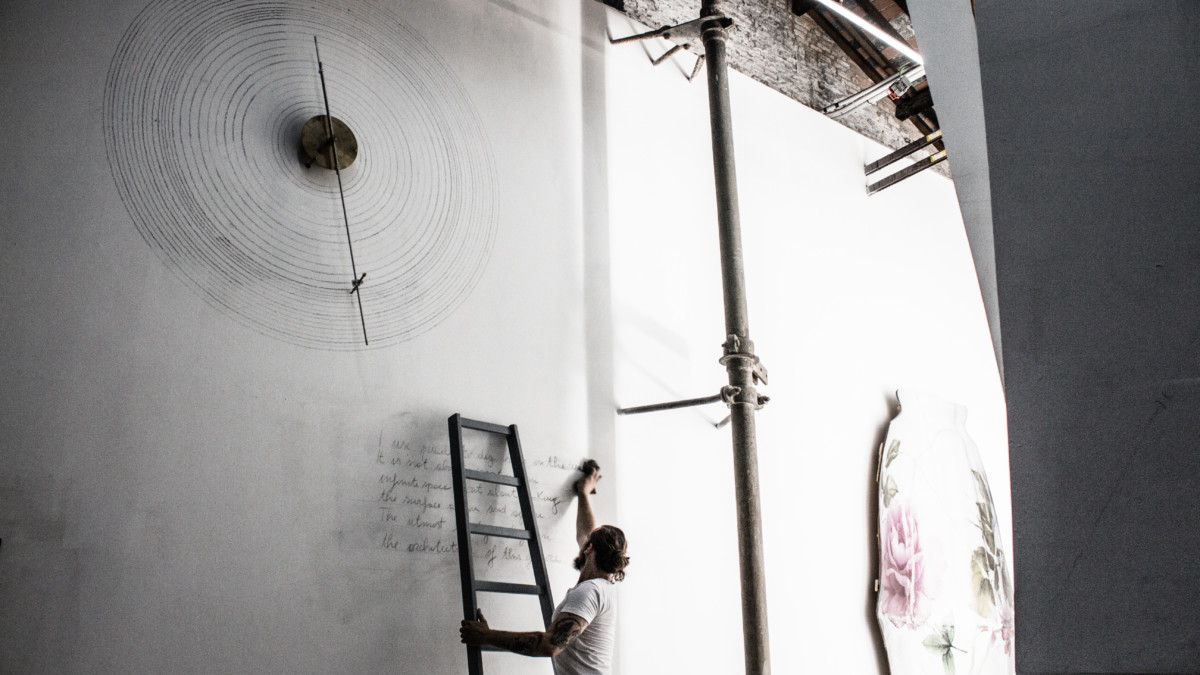
Guernica: Do you have a sense yet of how participating in the Biennale and performing UTTER has affected you and your collaborators?
JAŠA: Maybe the best example is this last Sunday, which was Day 6: we canceled for the twenty-seventh time. Well, we didn’t cancel—for me, it’s painting. Every Monday, I go over the writings on the wall with white paint, and I really enjoy this. In the beginning, I suffered a lot because I didn’t really understand why I forced myself and everybody else to do it, especially because I saw Michele suffering a lot. The first time, when I understood that I could make it easier for him, because he used to be a painter, I said, “Look it’s not about painting the walls white. You’re painting . . . so let’s leave the color draped, let’s work with it.” Everything became closer to the act of expressing, and this is when things become fun. You connect more. It’s not about precision anymore. We have the precision, but we can apply ourselves on top of this precision. We’re painting. It took us some time to do that.
But last Sunday, when I was doing it, there was this moment when I understood the process. I felt that through this, I was working on other previous projects that I love as much as I love UTTER. They were less complex than UTTER, but I managed to put all of the elements together into this one instrument. And after UTTER is finished, the instrument will mutate into another one.
I love to look at art as a science, so I’m constantly working on a kind of equation and I see so much already that I want to try. So much knowledge has accumulated through these seven months. A lot of things I’ve learned I haven’t applied yet, because it wasn’t the right moment. I’ve been storing the ideas because UTTER is its own frame, but from this pool of things a whole book is being written in the back of my mind. I cannot wait to channel this experience into a new instrument that will have a different sound, a different feel, and so on.
We can always keep returning to aggression and fear, even rage. These emotions that are causing so much pain in the world. Again, going back to Beuys, and the fact is that all human beings are creative, but it depends on how and where you channel your creativity. “Anger is a gift!” That’s a quote from Rage Against the Machine that woke me up many crazed nights and I still think that this is true, but only as a part of a creative process. When I talked about discipline before and related it directly to the understanding of what a creative process is, too many times it is solemnly linked to the romantic vision of the artist. Creative process embraces practically the whole spectrum of emotions, from what is completely devastating to almost unearthly highs, but you cannot expect to see it as a given or stable result. You always need to fight your way through it. Every high provokes a fall and vice versa, but each time you go through it, you learn, and you manage to add another tiny piece to the conception of existence. Togetherness in all of this is a fact, and I do believe that we are good and honest people, by choice.
